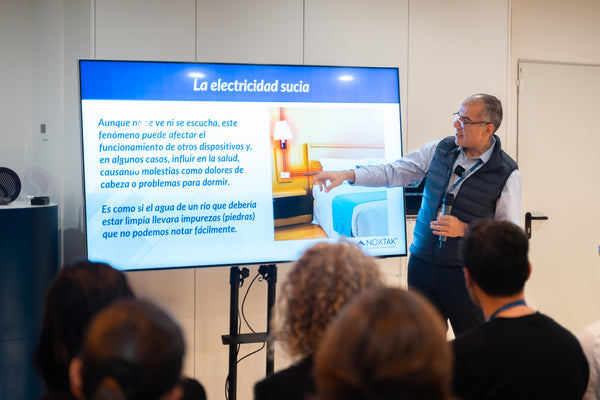
About Joaquin Machado
He is an acclaimed EMF researcher and electromagnetic pollution specialist, known for pioneering interference control in telecommunications and electrical lines. His innovative spirit led to the creation of SPIRO® technology, a groundbreaking approach in nanotechnology for mitigating electromagnetic interference, particularly from VHF/EHF microwave radiation. His efforts aim at harmonizing technological advancement with environmental wellness, making significant strides towards a future where digital and natural worlds coexist seamlessly.
About Joaquin Machado
He is an acclaimed EMF researcher and electromagnetic pollution specialist, known for pioneering interference control in telecommunications and electrical lines. His innovative spirit led to the creation of SPIRO® technology, a groundbreaking approach in nanotechnology for mitigating electromagnetic interference, particularly from VHF/EHF microwave radiation. His efforts aim at harmonizing technological advancement with environmental wellness, making significant strides towards a future where digital and natural worlds coexist seamlessly.
Electromagnetism, frequencies, and quantum vibrations are my passion, and thanks to them, I have a different perspective on what wellness and environmental health are. In the end, it all comes down to: Light, Magnetism, and Water. And that is what I want to share with the world.
Light
Understanding the light environment as electromagnetic waves that interact with our body to regulate our biology is key to well-being.
Magnetism
Understanding quantum magnetism as fundamental interactions that maintain the correct information in biological systems for the proper functioning of those systems is vital.
Water
Understanding water, especially in its "fourth state" or "organized" form, capable of storing information and energy, is EVERYTHING in vital processes.
My Latest Videos
Dirty Electricity: How It Affects Your Home and How to Fix It
Youtube — 3:10What is Electromagnetic Polarization and Why Should You Be Concerned?
Youtube — 4:55Electromagnetic Pollution and Health: How to Measure and Reduce Its Effects?
Youtube — 9:01Discover If Electromagnetic Pollution in Your Home Is Affecting Your Health
Youtube — 9:46The Science Behind SPIRO: Energy Efficiency and Electromagnetic Coherence
Youtube — 4:51Sharing Insights and Perspectives Through My Blog
Frequently Asked Questions to an Electromagnetic Pollution Expert
WHAT IS AN EXPERT IN ELECTROMAGNETIC POLLUTION?
WHAT IS AN EXPERT IN ELECTROMAGNETIC POLLUTION?
An electromagnetic pollution expert is a professional who studies, analyzes, and investigates the potential human and environmental risks of electromagnetic radiation emissions generated by the operation of electronic equipment and telecommunication signals.
To carry out these investigations and determine specific preventive actions, this expert employs various scientific methods and measurement technologies.
WHAT ARE THE KNOWLEDGE AREAS OF AN ELECTROMAGNETISM EXPERT?
WHAT ARE THE KNOWLEDGE AREAS OF AN ELECTROMAGNETISM EXPERT?
Among the areas of knowledge possessed by an expert in electromagnetic fields are the following:
- Electromagnets.
- Electricity.
- Mathematics.
- Electromagnetism.
- Consumer protection.
- Electromagnetic spectrum.
- Principles of Physics.
- Microwave principles.
- Engineering principles.
- Electrical engineering and electronic engineering.
- Regulations related to electrical equipment.
- Project blueprints.
- Environmental risks and threats.
- Environmental regulations.
- Principles of electricity.
WHAT ARE THE AREAS IN WHICH AN ELECTROMAGNETIC POLLUTION SPECIALIST WORKS?
WHAT ARE THE AREAS IN WHICH AN ELECTROMAGNETIC POLLUTION SPECIALIST WORKS?
Electromagnetic fields are commonly produced by transformer stations, medium and high voltage lines, electrical transformers, and everyday electrical equipment. An electromagnetic pollution expert typically works with various types of electromagnetic fields, which can be divided into several subclasses based on their physical characteristics of frequency and wavelength. Each of these fields will have associated energy ranges and therefore particular effects when interacting with matter.
Static electric fields: These are produced due to the presence of electric charges without any current. Any charge generates an electric field around it. These fields do not vary over time.
Static magnetic fields: These are generated by moving charges such as electric currents or permanent magnets.
Variable electromagnetic fields: These types of fields refer to time and radiation. They are generated by charges moving non-uniformly, with alternating current.
There are different types of variable electromagnetic fields:
- Extremely low-frequency fields: They fall within a frequency range of 3 Hz to 3 kHz and are typically produced by electrical distribution networks or electrical appliances operating at 50 Hz.
- Radiofrequency fields: Their frequency range fluctuates between 3 kHz and 300 MHz. Sources generating them include induction cooktops, arc welding equipment, and modulated broadcasting antennas, etc.
- High-frequency or microwave fields: Their frequency range extends from 300 MHz to 300 GHz. Some examples of electromagnetic pollution sources are traffic radars or microwave ovens.
Experts in electromagnetic fields provide measurement and diagnostic services for electromagnetic interference. Once they identify the source of the interference through measurements of the affected equipment's electromagnetic environment, they can propose solutions, which often involve relocating one of the devices or installing a protective shield around the emitting or affected equipment.







